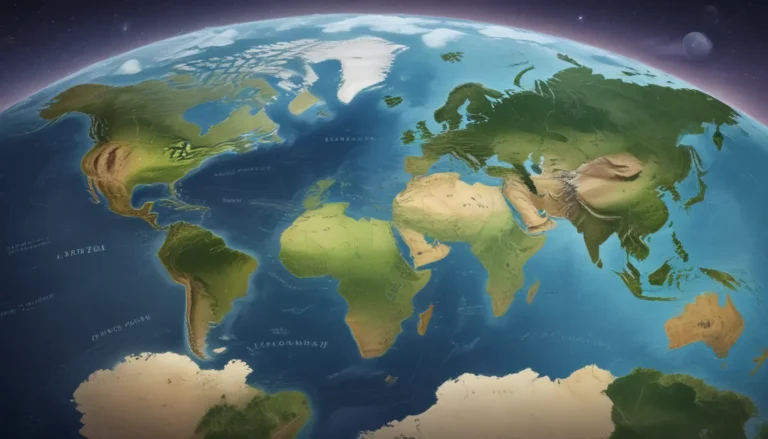A Note About Images: The images used in our articles are for illustration purposes only and may not exactly match the content. They are meant to engage readers, but the text should be relied upon for accurate information.
The Earth is a fascinating and ever-changing planet, with constant shifts and movements occurring beneath our feet. One of the most intriguing phenomena that shape our landscapes and trigger seismic activity are geologic faults. These fractures in the Earth’s crust play a vital role in the dynamic forces that shape our planet. While geologists study faults extensively, there are still many surprising facts that most people are not aware of. In this article, we will explore 17 surprising facts about geologic faults that will expand your understanding of the Earth’s dynamic nature. From the world’s largest fault to the role faults play in shaping our landscapes, get ready to be amazed by the wonders that lie beneath our feet. Let’s embark on a journey to uncover these intriguing facts and gain a deeper appreciation for the forces that shape our planet.
Delving into the World of Geologic Faults
Geologic faults are fractures in the Earth’s crust where rocks on either side of the fault slip and slide past each other. These fractures can range in size from small, barely noticeable cracks to massive fault lines that span hundreds of kilometers. The movement along faults can lead to earthquakes, the formation of landforms, and even the creation of valuable mineral deposits. Geologic faults are dynamic features that are essential in shaping the Earth’s surface and providing valuable insights into plate tectonics, earthquake activity, and the formation of natural wonders.
The San Andreas Fault: A Geological Icon
The San Andreas Fault in California is one of the most famous geologic faults in the world. Stretching approximately 1,300 kilometers (800 miles), this fault is responsible for numerous earthquakes in the region. The movement along the San Andreas Fault has captured the fascination of scientists and the public alike, highlighting the significant impact faults can have on the Earth’s surface.
Unveiling the Diversity of Fault Movement
Faults can exhibit varying rates of movement, from slow, gradual shifts to rapid, high-magnitude earthquakes. Strike-slip faults, in particular, can generate rapid sideways motion, leading to significant seismic events. Geologists classify faults into different types based on the direction of movement, such as normal faults, reverse faults, and strike-slip faults. This classification aids in understanding the complex forces at work within the Earth’s crust.
The Role of Faults in Earthquake Generation
Stress buildup along fault lines can result in earthquakes when rocks are unable to withstand the pressure, causing them to slip and release energy in the form of seismic waves. These seismic events can be measured and studied by seismologists to better understand earthquake activity and assess potential risks associated with fault movement.
Transforming Landscapes Through Fault Activity
The movement along geologic faults over millions of years can create dramatic landforms, including fault scarps – steep cliffs formed by the displacement of rocks. These unique features showcase the transformative power of fault activity in shaping our landscapes and creating visually stunning geological formations.
Exploring the Depths of Fault Activity
While we often associate fault lines with land, they can also exist beneath the ocean, triggering underwater seismic events. These underwater faults can have significant implications, potentially leading to tsunamis when they rupture and displace large amounts of water. Geologists use various mapping and monitoring techniques to track fault activity, essential for identifying areas of high seismic risk and preparing for potential earthquakes.
Unraveling the Connection Between Faults and Plate Tectonics
Faults are intricately linked to plate tectonics, the scientific theory that explains the movement of Earth’s lithospheric plates. By studying faults, scientists can gain insights into plate movements and how they shape the Earth’s surface. Understanding the complex interplay between faults and plate tectonics is crucial for predicting seismic events and understanding the geologic processes at work beneath our feet.
Unlocking the Mineral Wealth of Fault Zones
Faults create pathways for mineral-rich fluids to flow through the Earth’s crust, resulting in significant mineral deposits. The mining industry often explores fault zones for valuable minerals, highlighting the economic importance of faults in providing essential resources. These mineral-rich environments showcase the diverse ways in which faults influence the Earth’s geology and natural resources.
Embracing the Evolution of Faults Over Time
Faults are not static features but can change and evolve over time due to various factors, including stress on rocks and the presence of fluids. This dynamic nature adds complexity to fault studies, emphasizing the ever-changing landscape of the Earth’s crust. The continuous movement along faults showcases the dynamic forces at play within the Earth’s interior and the transformative impact they have on our planet’s surface.
Celebrating the Beauty of Fault-Created Landscapes
Fault activity can result in the formation of breathtaking landscapes, such as the iconic Grand Tetons in Wyoming, USA. The uplift along a fault line led to the creation of these stunning geological formations, showcasing the powerful and majestic forces that shape our planet. These natural wonders serve as testaments to the enduring impact of fault activity on our landscapes and the natural beauty they create.
Connecting Faults to Volcanic Activity
Certain geologic faults are closely associated with volcanic activity, creating pathways for magma to reach the surface and forming volcanoes and volcanic eruptions. The movement along these faults plays a pivotal role in shaping volcanic landscapes and influencing geologic processes that lead to volcanic events.
Deciphering Earthquake History Through Fault Analysis
By studying the displacement and offset of rocks along fault lines, geologists can reconstruct the history of past earthquakes. This information is crucial for assessing seismic hazards in specific regions and understanding the frequency and intensity of seismic events over time. Fault analysis provides invaluable insights into earthquake recurrence intervals and helps scientists predict and prepare for future seismic activity.
Navigating the Aftermath of Fault-Triggered Earthquakes
Following a major earthquake, aftershocks can occur along fault lines, varying in magnitude and duration. These subsequent seismic events can continue for days, weeks, or even months after the initial earthquake, highlighting the ongoing seismic activity associated with fault movement. Understanding the aftermath of earthquakes along faults is essential for effective disaster preparedness and response efforts.
Embracing the Dynamic Nature of Earth’s Crust Through Geologic Faults
The 17 surprising facts about geologic faults offer valuable insights into the dynamic forces shaping our planet’s surface. From triggering seismic events to creating mineral-rich environments, faults play a crucial role in Earth’s geologic processes. By studying these faults, scientists can anticipate and prepare for future earthquakes, ensuring the safety and well-being of communities worldwide. As we unravel the mysteries of geologic faults, we gain a deeper appreciation for the intricate interplay of forces that shape our planet’s landscapes and shape its geologic history.
Conclusion
In conclusion, geologic faults are captivating natural features that leave a lasting impact on Earth’s surface. From their role in earthquake generation to their ability to create mineral deposits, faults are essential elements in the dynamic forces that shape our planet. By exploring the diverse types of faults and understanding their behavior, we gain valuable insights into the ever-changing nature of Earth’s crust. The study of fault zones and their geological features provides a window into the past, present, and future seismic activity, enabling us to predict and mitigate earthquake hazards effectively. Geologic faults are not only geological wonders but also influential forces that shape our planet’s geology and seismic activity, reminding us of the intricate beauty and power of Earth’s dynamic nature.






